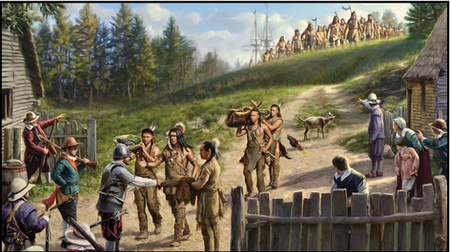
The Seizure and Transformation of Mount Hope
Mount Hope, seized from the Pokanoket in 1676, undergoes a centuries-long journey of colonial ownership and eventual partial restoration to Indigenous stewardship.

In 1676, following the death of Metacom (King Philip) near Mount Hope, the Plymouth Colony immediately seized Pokanoket lands, including Potumtuk (Mount Hope), as spoils of war. Colonial authorities branded the Pokanoket as “enemies” and declared their homeland forfeit. The consequences were devastating as Pokanoket survivors were executed, enslaved, or scattered into diaspora, leaving their ancestral grounds open to colonial redistribution.¹
As was common practice in New England, the conquered lands were quickly sold or granted to English settlers, military officers, and speculators. These transfers rewarded soldiers and helped pay colonial war debts.² Mount Hope itself, deeply symbolic as the site of Metacom’s death, was swiftly parceled into colonial estates.³
Over the ensuing centuries, ownership of Mount Hope passed through the hands of several wealthy families. By the late nineteenth and early twentieth centuries, it had become the estate of the Haffenreffer family, industrialists who also established a private museum on the site to display Native artifacts.⁴ In 1955, the Haffenreffer family donated approximately 375 acres, including Mount Hope, to Brown University. Nearly seventy years later, in 2024, Brown University transferred 255 acres of this land into a preservation trust under Pokanoket stewardship, marking a significant step toward restoring Indigenous ties to a homeland taken nearly three and a half centuries earlier.⁵
References
Jill Lepore, The Name of War: King Philip’s War and the Origins of American Identity (New York: Knopf, 1998), 142–47; Daniel R. Mandell, King Philip’s War: Colonial Expansion, Native Resistance, and the End of Indian Sovereignty (Baltimore: Johns Hopkins University Press, 2010).
Yasuhide Kawashima, Puritan Justice and the Indian: White Man’s Law in Massachusetts, 1630–1763 (Middletown, CT: Wesleyan University Press, 1986), 97–101.
Neal Salisbury, “The Indians’ Old World: Native Americans and the Coming of Europeans,” William and Mary Quarterly 53, no. 3 (1996): 435–58.
Christina H. Nelson, A Century of Collecting: The Haffenreffer Museum of Anthropology (Providence: Brown University, 2003).
Brown University, “Brown Transfers 255 Acres at Mount Hope to Pokanoket Tribal Trust,” news release, November 15, 2024.














